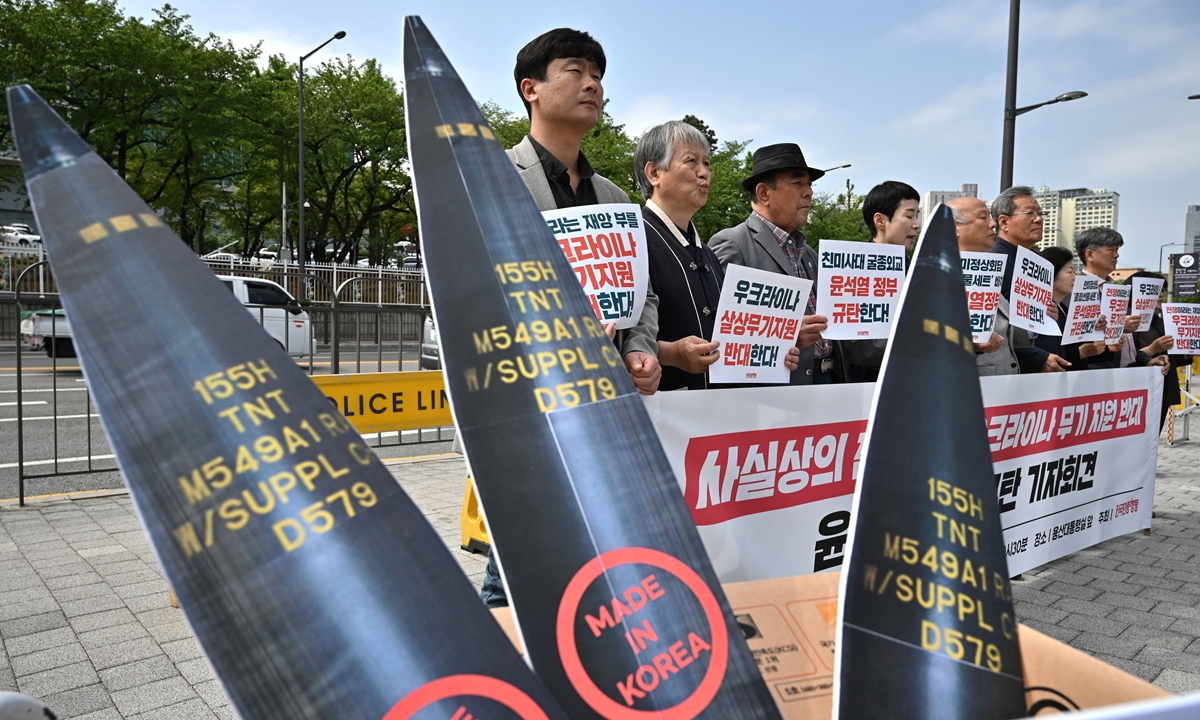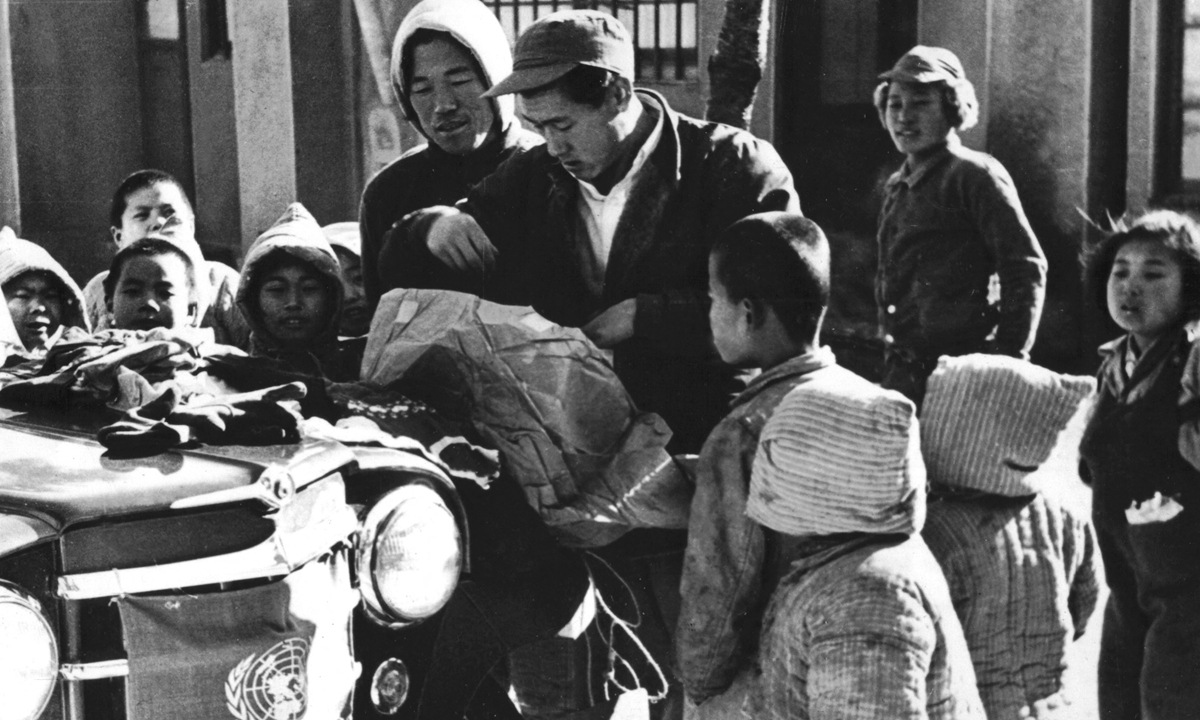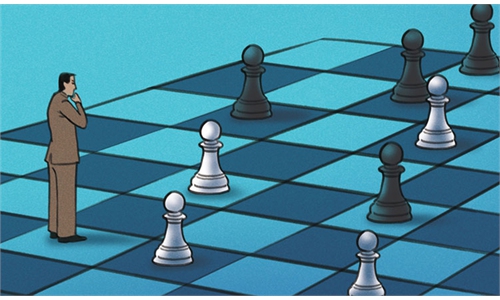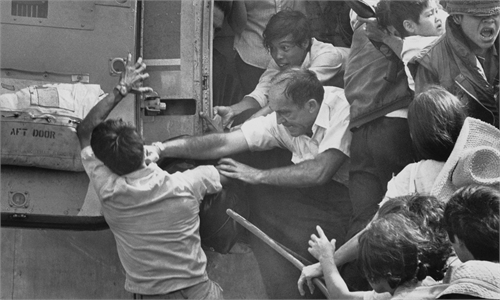IN-DEPTH / IN-DEPTH
Bombs, hunger, specter of death… what US left behind after partially withdrawing troops from Korean Peninsula
Lingering evil

Activists hold placards next to cardboard cutouts depicting South Korean-made artillery shells during an anti-government protest near the Presidential Office in Seoul, on April 21, 2023, ahead of South Korean President Yoon Suk-yeol's planned visit to Washington to meet with US President Joe Biden. Photo: AFP
Editor's Note:
After the end of the Korean War in 1953, most of the US' troops withdrew from the Korean Peninsula, leaving behind a mess - economic stagnation made people suffer from the effects of famine, and the leftover undetonated bombs still threaten their lives, along with a mushrooming of military bases. All of these have had a significant impact on South Korea politically, economically, and socially, among other fields.
The three-year Korean War not only killed millions of people in the Korean Peninsula, but also dealt a devastating blow to the region's economy. What the US was most concerned with in the Korean Peninsula was its own best interests, which was to prevent the reunification of North and South Korea. As for how the local people live, it was not within the US considerations.
According to reports, in the decade after 1953, South Korea's economy saw no improvements. The annual GDP growth rate was only about 4 percent, which was only a fraction of North Korea's economic growth rate in the north of the peninsula during the same period. But according to experts, South Korea's 4-percent GDP growth was not accurate, for if population growth were to be taken into account, South Korea's economic growth rate would only have been about 2 percent per year. This made South Korea one of the poorest countries in the world at the time.
In the years after US withdrawal, a shadow of invasion still loomed large in the country in the form of a severe famine. Years of war had rendered much of the arable land unusable, causing the shortages in agricultural supplies, the result of which was reduced food production which triggered a large number of refugees to flee their hometowns.
The typically carnivorous American palate also meant that US troops stationed in Japan and South Korea maintained their great demand for meat. Much of the local livestock that could be reared for farming was transported to Japan as meat. According to records, this resulted in a reduction of more than 50 percent in the number of livestock, and farming cattle were used to produce steaks so beloved by the American military men. Aside from the reduction in farming livestock, chemical fertilizers were also in short supply. Since many raw materials used to make fertilizers could also be used to make bombs and gunpowder, they were requisitioned by the army.
It can be said that the word "hunger" was regarded as a key word in the Korean Peninsula in the 1950s and 1960s. Although media reports are scarce, some netizens recall the lives of the then older generation on some Korean online forums and note that because of the lack of food, most people would only eat two meals a day.
Another topic in the South Korea's education can also be studied through the lens of the famine suffered by the country. It is generally believed that South Korea's later rise was largely due to the Korean people's emphasis on education. While suffering from hunger, Koreans insisted on popularizing primary and secondary education. Someone recalled that there were as many as hundreds of students in classrooms in elementary and middle schools back then.
In order to attract students to enroll, one of the powerful incentives introduced by schools was the promise of a meal. And this meal was often gruel mixed with corn, which meant that a simple bowl of porridge could attract many students to happily attend school, and would encourage many parents to enroll their children.
Aside from eating porridge, the common collective memory and hobby of the elderly generation in South Korea was digging for wild vegetables. In order to resist hunger, wild vegetables in the mountains became the delicacy of that era.
Another common memory tied to the years of famine is corn, one of the many staple foods. Corn was also called "feed corn" in South Korea at the time. The US once shipped a large amount of surplus corn to South Korea as aid, a product basically used as livestock feed in the US, but after being shipped to South Korea, it became a staple food of the local people.
In the 1950s, before and after the Korean War, the people of South Korea were starving under the rule of the US military and the military government supported by the US military. People in the North also lacked clothing and food because of the war. In the following decades, both the North and the South were often shrouded in the shadow of war, and the pressure of the arms race had a serious impact on economic and agricultural development. North Korea had since been under the economic blockade of the US and its allies, and the people's lives were made all the more miserable.
Bombs and chemical pollution
After the end of the Korean War, although the US withdrew, the countless bombs, mortars, and live ammunition fragments left behind by the US military in North Korea have continued to threaten the lives of local people for decades.
Media reports showed that South Korea and North Korea have cleaned up countless bombs and other dangerous items left behind by the US military for decades. Both countries have complained that the bomb remains were far from being cleared with many bombs yet to be found and removed. The Korean Peninsula is one of many places in the world where explosive remnants of war are still being cleared.
According to reports by the Korean Central News Agency, North Korea has discovered and dismantled more than 800,000 unexploded ordnances since the end of the Korean War in 1953, including butterfly bombs dropped by the US military, as well as other landmines, large bombs, and artillery shells.
Since the beginning of this century alone, more than 200,000 remnants of various types of explosives have been discovered and dismantled in various parts of North Korea, including many large bombs weighing hundreds of kilograms. In recent years, with the pace of construction and development, bombs or shells left behind by the US military have been continuously found on the construction sites of new projects in Pyongyang. Previously, a huge bomb weighing one ton dropped by the US military during the war was discovered in the Taedong River in Pyongyang.
South Korea has also continued to report the discovery of bombs or shells left behind by the US military. Some unexploded bombs have been dug up at construction sites. Although the bombs' shells have rusted, their explosive potential still exists with the added risk of unstable compounds which may detonate such bombs at any time.
Some declassified US, Canadian, and British documents have revealed the truth. They provide evidence that the US had an operational bacteriological weapons system and used it during the Korean War. After the Korean War, the pollution left over from the bacterial warfare and biochemical warfare carried out by the US military on the peninsula during the war still poses a threat to the safety and health of the Korean people.
Some Korean historians have also pointed out that during the Korean War, many villagers near Gyeonggi-do were harmed by infectious diseases triggered by bacteriological warfare. From the time of US military withdrawal to present day, South Koreans are still concerned about their safety. Some media reports have revealed that in recent years, the US military has shipped extremely dangerous biochemical specimens such as anthrax bacillus and plague bacillus to US military bases in the South Korea for experiments, causing panic among the public.
With the continuous exposure of news about the biochemical experiments conducted by the US military in the South Korea, the displeasure and anger of the South Korean public has become increasingly high. Many civil groups have been continuously protesting outside US military bases. The actions of the US military are not only dangerous and unethical, but also violate South Korean law. Some of the places where the US military conducted biochemical experiments were surrounded by densely populated areas, including several primary and secondary schools, according to some reports.
Since the US' withdrawal from the Korean War, there have been more than 40 military bases left in the South Korea. In recent years, with the continued protests by the South Korean people, some of the bases have been returned to South Korea.
Around 28,500 US troops are currently still stationed in South Korea, according to media reports.
However, the pollution issue of the returned military bases has always troubled the South Koreans. Because some areas where biochemical materials were stored may cause pollution that is difficult to assess, there is no consensus on how long the harm might last.

File photo: Korean War orphans gather around a United Nations jeep to examine the contents of parcels. Photo: AFP
Assassination and exileDue to the US' deep involvement in the affairs of the Korean Peninsula, the regime in the south of the Peninsula has always relied on the protection of the US, especially the US forces stationed in South Korea. This has, to some extent, led to a characteristic of the South Korean political arena, especially South Korean leaders, of often being torn between two eternally contradictory options: One is to act as a US puppet, completely obeying and serving the strategic interests of the US with the South Korean people; the other is to take an independent and self-reliant path, but this choice will inevitably dissatisfy US.
Since the 1940s, few South Korean presidents have been able to "retire unscathed" in politics. Some have been forced to flee abroad, some have been overthrown in coups, some have been implicated and imprisoned, and some have committed suicide or been assassinated... The fate of many former South Korean presidents can be described as "miserable" so much so that the presidency of South Korea was once called "the most dangerous job in history."
In this regard, a somewhat superstitious theory has arisen in South Korea, suggesting that the "Feng Shui" of the Blue House, where the presidential office is located, is problematic, and this has brought "bad luck" to every politician who has "moved into" the Blue House.
Recently, South Korean President Yoon Seok-yeol announced that he would move all presidential offices and official residences out of the Blue House to a new location, according to media reports. Yoon's decision breaks decades of tradition in South Korea and is considered by many to be aimed at changing the "Feng Shui."
However, some Korean public opinion analysis states that South Korea, as a small country, has never had the ability to determine its own destiny, and it can't even have independent wartime command authority. The influence of the US is evident in South Korea's domestic and foreign affairs, which is the real "Feng Shui" affecting South Korea and is at the root of the tragedies of successive South Korean presidents.
The fate of the family of former South Korean president Park Geun-hye is quite representative. First, Park Geun-hye's mother was killed in an assassination attack. Then Park Geun-hye's father, then-president Park Chung-hee, was shot by Kim Jae-kyu, the former head of the Korean Central Intelligence Agency, on October 26, 1979, and Park Geun-hye, who succeeded her father, eventually ended up in prison tragically.
The death of Park Chung-hee shocked the world at the time, and the issues exposed during the trial made the event more mysterious. Kim claimed during his trial that the US was behind him, and a few hours before the assassination, Kim had met with the US ambassador to Korea.
The US side has firmly rebutted Kim's claims. However, many people have their own views and judgments on the matter. Some people think that the death of Park Chung-hee was very strange, a mystery, and the US claiming that it has nothing to do with is like "a guilty person giving himself away by consciously protesting his innocence."
Others have compared the tragedy of the former South Korean leader with the unfortunate outcomes of leaders in Iran, Nicaragua, and El Salvador at the time to conclude that these series of events were all related.
According to local media reports, during his tenure, Park Chung-hee developed heavy industries, including the military industry, in disregard of US opposition. He adopted a series of strategies to gradually escape US control, attempting to explore the path of economic self-reliance, independent defense, and stronger diplomacy.
After the US withdrawal, South Korea was left with a semblance of a democratic system. Starting with the founding President Syngman Rhee, who was supported by the US, South Korean leaders occasionally relied on the power of chaebols and gangsters to suppress the opposition party and win more votes. Rhee was forced to exile overseas in 1960. The catalyst for the incident was widespread public protests and opposition due to election fraud by using the power of gangsters.
To this day, when the media reports of political corruption and instability in South Korea, the shadows of these "two cancers" can still be seen behind it. And the initial rise of some chaebol forces originated from their close cooperation with the US in the post-Korean War period.


